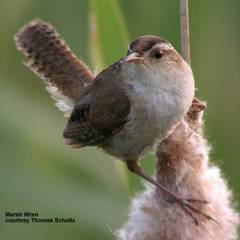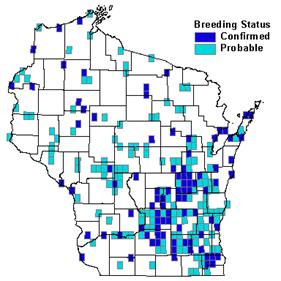Photo by Thomas Schultz


Status/Protection
- Global Rank: G5 Key to global and state ranks
- State Rank: S4B
- WBCI Priority: PIF
Population Information
Federal BBS information can be obtained at http://www.mbr-pwrc.usgs.gov/bbs/bbs.html by clicking on Trend Estimates and selecting the species in question. All estimates are for 1966-2005.
- Federal Breeding Bird Survey: significant increase
- Federal Breeding Bird Survey (WI): non-significant decline
- Federal Breeding Bird Survey (BCR 23): N/A
- Federal Breeding Bird Survey (BCR 12): non-significant increase
- WSO Checklist Project: significant inverted u-shaped trend (1983-2007)
Life History
- Breeding Range: Across northern U.S., southern Canada and north into northern Saskatchewan, the intermountain west, and along both coasts including the Gulf of Mexico (Kroodsma and Verner 1997).
- Breeding Habitat: Emergent Marsh.
- Nest: Dome made of sedges, grasses and cattail supported by robust emergents (Kroodsma and Verner 1997).
- Nesting Dates: Eggs: late May to early July (Robbins 1991, Baughman 2006).
- Foraging: Foliage gleans, hawks (Ehrlich et al. 1988).
- Migrant Status: Short-distance migrant, Neotropical migrant.
- Habitat use during Migration: Freshwater and saltwater wetlands, estuaries; similar to breeding habitat but in a wider variety of types (Kroodsma and Verner 1997).
- Arrival Dates: Late April to late May (Robbins 1991).
- Departure Dates: Early September to early November (Robbins 1991).
- Winter Range: Wisconsin populations probably winter along the southern Atlantic and Gulf coasts and south to central Mexico (Kroodsma and Verner 1997).
- Winter Habitat: Similar to habitat used on migration (Kroodsma and Verner 1997).
Habitat Selection
The Marsh Wren is an obligate wetland species requiring dense stands of robust emergents over shallow standing water. It nests in wetlands containing cattails, river bulrush, phragmites and other emergent vegetation (Kroodsma and Verner 1997, Baughman 2006) but avoids wetlands dominated by purple loosestrife (Maddox and Wiedenmann 2005). Multiple studies indicate that Marsh Wren numbers and density were positively correlated with emergent vegetation cover, overall area of emergent vegetation, and proximity to other suitable wetland habitats (Zimmerman et al. 2002). Limited studies at Delta Marsh, Manitoba suggest that nesting success is higher in areas with taller, denser and more diverse stands of emergents over deeper water than in monotypic cattail stands in shallower water (Leonard and Picman 1987). Conversely, Manci and Rusch (1988) found that Marsh Wren densities at Horicon Marsh were higher in cattail stands than in river bulrush stands. Multiple studies show a preference for nesting in live emergents rather than in dead residuals (Zimmerman et al. 2002).
Males build numerous dummy nests within a territory for use in both the breeding and non-breeding seasons. A higher number of nests may correlate to higher nesting success and/or indicate a higher level of male fitness (Kroodsma and Verner 1997). Marsh Wrens have small home ranges (approx 0.08 ha) and are found across a number of wetland size classes (1 ha and up).
Habitat Availability
Marsh Wrens were found breeding in almost every county during the recent Breeding Bird Atlas (Baughman 2006) but the core breeding population occurs within the Southeast Glacial Plains ecological landscape and to a lesser extent the Northern Lake Michigan Coastal and Central Sand Plains ecological landscapes.
Population Concerns
A lack of population data for this species in Wisconsin and the western Great Lakes region makes it difficult to assess the overall health of the Marsh Wren population in this region. The long term loss and degradation of wetlands has probably resulted in Marsh Wren population declines in Wisconsin and in the upper Midwest. Invasive species such as purple loosestrife, hybrid cattail, and phragmites are rapidly changing many emergent marsh ecosystems, and it’s not known how this will impact Marsh Wren populations.
Recommended Management
There are very few experimental studies that analyze this species response to management. In general, management practices that promote dense, diverse stands of emergent vegetation over standing water will benefit Marsh Wrens. This may require periodic drawdowns to revegetate and revitalize emergent vegetation stands, which should be highly compatible with waterfowl breeding habitat management and restoration. Many studies have found that this species colonizes restored wetlands, although some studies suggest lower densities at these sites compared to natural wetlands. Restoration projects should focus on creating wetland complexes with a variety of age classes and vegetational stages across wetland cycles (Zimmerman et al. 2002).
The Southeast Glacial Plains ecological landscape provides the greatest opportunity for protecting and restoring emergent wetlands for this and other marsh birds. This species also commonly occurs in emergent marshes within the Central Sand Plains and Northern Lake Michigan Coastal ecological landscapes. Key sites for this species include Horicon Marsh, Rush Lake, the west shore of Green Bay, and other large emergent marsh complexes.
Research Needs
Implementation of a marshbird monitoring program in Wisconsin and the larger region will help determine the conservation status for this and other marshbird species. To better guide future restoration efforts, more research is needed on specific habitat features associated with reproductive success, including total wetland area, patch size, and the impact of invasive species. A state assessment of the distribution, abundance, conditions, and ownership of wetlands and other important wetland bird habitats also would further management efforts.
Information Sources
- Cornell Lab of Ornithology species account: http://www.birds.cornell.edu/AllAboutBirds/BirdGuide/Marsh_Wren.html
- Effects of Management Practices on Wetland Birds: Marsh Wren : http://www.npwrc.usgs.gov/resource/literatr/wetbird/mawr/mawr.htm
- Wisconsin Breeding Bird Atlas: http://www.uwgb.edu/birds/wbba/
References
- Baughman, J. 2006. Marsh Wren. In Atlas of Breeding Birds of Wisconsin. (N.J. Cutright, B.R. Harriman, and R.W. Howe, eds.). The Wisconsin Society for Ornithology, Inc. 602pp.
- Ehrlich, P.R., D.S. Dobkin, and D. Wheye. 1988. The birders handbook: a field guide to the natural history of North American birds. Simon & Schuster, Inc. New York.
- Kroodsma, D.E., and J. Verner. 1997. Marsh Wren (Cistothorus palustris). In The Birds of North America, No. 308 (A. Poole and F. Gill, eds.). The Academy of Natural Sciences, Philadelphia, PA, and The American Ornithologists’ Union, Washington, D.C.
- Leonard, M.L. and J. Picman. 1987. Nesting mortality and habitat selection by Marsh Wrens. Auk 104: 491-495.
- Maddox, J.D. and R.N. Wiedenmann. 2005. Breeding phenology and nest success of three bird species nesting in wetlands containing purple loosestrife (Lythrum salicaria) and cattail (Typha spp.). Natural Areas Journal 25: 369-373.
- Manci, K.M. and D.H. Rusch. 1988. Indices to distribution and abundance of some inconspicuous waterbirds on Horicon Marsh. J. Field Ornithol. 59: 67-75.
- Robbins, S.D. 1991. Wisconsin birdlife: population & distribution, past & present. Univ. of Wisconsin Press, Madison, WI.
- Zimmerman, A.L., J.A. Dechant, D.H. Johnson, C.M. Goldade, J.O. Church, and B.R. Euliss. 2002. Effects of management practices on wetland birds: Marsh Wren. Northern Prairie Wildlife Research Center, Jamestown, ND. Northern Prairie Wildlife Research Center Online. http://www.npwrc.usgs.gov/resource/literatr/wetbird/mawr/mawr.htm (Version 01JUL03).
Contact Information
- Compiler: Andy Paulios, Andy.Paulios@Wisconsin.gov
- Editors: Kim Kreitinger, K.Kreitinger@gmail.com
